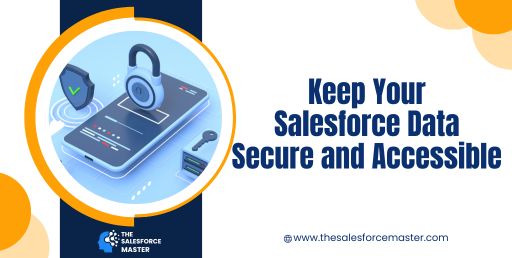
Keeping your Salesforce data secure and accessible is paramount for businesses relying on the platform. Here are some strategies to achieve this:
Implement Strong User Authentication: Utilize robust authentication methods such as multi-factor authentication (MFA) to ensure only authorized users can access Salesforce data. Enforcing strong password policies and regular password updates adds an extra layer of security.
Control Access with Profiles and Permission Sets: Define access levels for users based on their roles and responsibilities using profiles and permission sets. Limit access to sensitive data to only those who require it for their job functions.![]()
Data Encryption: Encrypt sensitive data at rest and in transit to prevent unauthorized access. Salesforce offers encryption options for both data stored within the platform and data exchanged between Salesforce and external systems.
Monitor and Audit Data Access: Implement monitoring tools and audit trails to track user activity within Salesforce. Regularly review logs and reports to detect any unauthorized access attempts or suspicious behavior.
Regular Data Backups: Perform regular backups of your Salesforce data to ensure data availability in case of accidental deletion, data corruption, or system failures. Utilize Salesforce’s built-in data export tools or third-party backup solutions for this purpose.
Train Users on Security Best Practices: Educate your Salesforce users on security best practices such as recognizing phishing attempts, safeguarding login credentials, and adhering to data access policies. Regular training sessions and reminders can help reinforce these practices.
Stay Updated with Security Patches and Updates: Keep your Salesforce instance up-to-date with the latest security patches and updates provided by Salesforce. Regularly review Salesforce’s security advisories and apply necessary patches promptly to mitigate potential vulnerabilities.
Utilize IP Restrictions and Trusted Networks: Configure IP restrictions and trusted networks to limit access to Salesforce from specific locations or networks. This helps prevent unauthorized access attempts from unknown or untrusted locations.
Implement Data Loss Prevention (DLP) Policies: Define and enforce data loss prevention policies within Salesforce to prevent sensitive data from being leaked or shared inappropriately. Utilize features like data classification, data loss prevention rules, and encryption to safeguard sensitive information.
Regular Security Assessments and Penetration Testing: Conduct periodic security assessments and penetration testing to identify and address vulnerabilities in your Salesforce implementation. Engage with security experts or third-party vendors to perform comprehensive assessments and ensure your Salesforce environment remains secure.
Summary
By following these strategies, you can maintain the security and accessibility of your Salesforce data, safeguarding it against unauthorized access and potential threats.
For more updates about the salesforce, visit us at www.thesalesforcemaster.com

